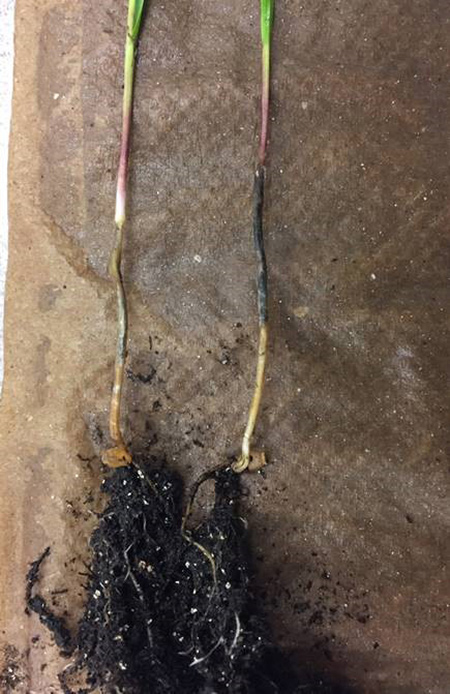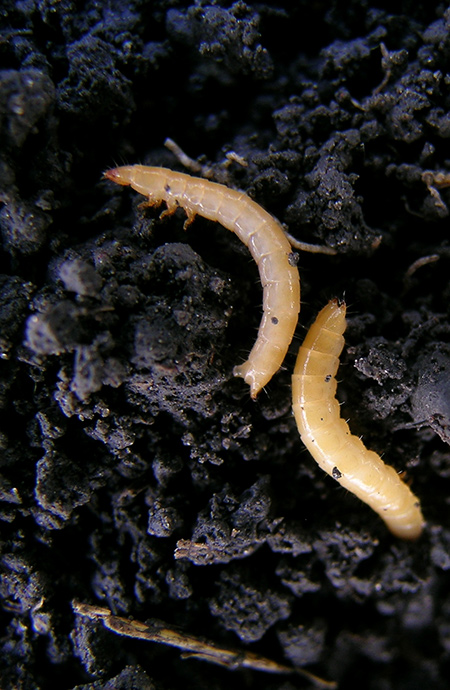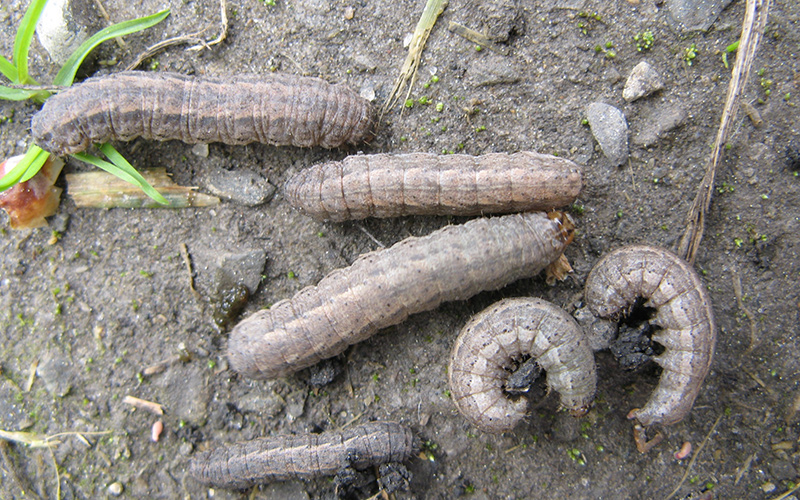Seedling Diseases
Seed rots, seedling blight and common root rot are part of the cereal seedling disease complex in
Western Canada caused primarily by Cochliobolus sativus (C. sativus) and multiple Fusarium
species. These pathogens can be both seedborne and soilborne. Seed becomes infested when spores released from
infested plant tissue or residues land on the developing heads and infect the structures. Highly infested seeds
often have lower germination and vigor and are more susceptible to seed rot. It is not unusual for the infection
to move from the seed to the seedling, causing lesions or necrosis of the developing roots and coleoptile which
may lead to seedling death before emergence or shortly after. Infections caused by soilborne spores or mycelia
arising from plant residues may cause similar symptoms. Aboveground symptoms are often nondescript and may include
stunting, chlorosis, reduced tillering, smaller heads and premature ripening. The impact of these diseases may be
exacerbated when hot and dry conditions persist through flowering and grain fill. Yield losses are variable but
losses up to 17% have been reported.1
Cochliobolus sativus only infects cereals and is most often associated with common root rot, which can be
diagnosed by the presence of distinct, dark brown lesions on the roots and, in particular, on the subcrown
internode. Most Fusarium species are capable of infecting multiple host species including cereals,
pulses, and canola. Early root symptoms may show a reddish brown discolouration without a distinct margin and
cracks may appear along the main roots.
Fusarium root rots and Fusarium head blight (FHB) are often caused by the same pathogens but represent different
stages of the same disease cycle. Although Fusarium graminearum (F.graminearum) is most commonly
associated with FHB it is not the only Fusarium species to infect kernels and affect seed performance. It
is therefore important when considering a disease test result that the total amount of Fusarium present
in the seed, regardless of species, is used to assess the risk associated with that seed. The pathogen’s preferred
environmental conditions are highly variable depending on species, but disease severity tends to increase with
intermittent wet/dry cycles. Management includes:
- Nutrient management- Fertilize the right amount and avoid excessive nitrogen
fertilization.1
- Seed placement- Avoid deep seeding.1
- Seed testing- A germination test can be used together with a fungal scan to understand seed
quality. Germination may test low for many reasons. However, if infection from C. sativus, Fusarium
species, or a combination of these, is high and germination is low, these pathogens may be causing reduced
germination. In this case, seed treating could help increase germination rate.
- Seed treatment- Including a seed treatment can help protect the seedling from both seed and
soilborne pathogens.
 Figure 1. Seedlings infected with C. sativus showing characteristic lesions on the
subcrown internode.
Figure 1. Seedlings infected with C. sativus showing characteristic lesions on the
subcrown internode.
Pythium species also cause seed rot and root rot. Browning root rot or Pythium root rot is a soil-borne
disease and is most detrimental in cold, wet soils. Seedlings may be chlorotic or have purpling, similar to
nutrient deficiencies, and root tips and lateral roots may appear pruned or absent. Generalized stunting as the
crop develops is common. Symptoms will be most obvious in low lying areas where moisture collects. Management
includes soil drainage, adequate phosphorous fertility, and seed treatment.2
Bacterial streak and black chaff caused by Xanthomonas translucens pv. undulosa
occur sporadically but are becoming more prevalent in Western Canada. These bacteria are primarily seedborne but
will overwinter in crop residue. Seed treatments and foliar fungicides are not effective in controlling this
disease and commercial seed tests are not yet available to identify infested seed lots. Awareness is key to
preventing the spread of this disease which can spread by contact with people or equipment or by planting infected
seed. The symptoms appear on leaves as light green water-soaked spots or streaks becoming yellow and necrotic. A
yellowish discharge from the leaf, typical of bacterial infection, is a key identifying feature when present. Seed
heads of cereal crops can also be infected by this pathogen though the symptoms appear on the glumes as dark lines
and severe infection can entirely blacken glumes.3
Smut is a disease of concern in all cereals, but especially in barley. Of the smuts, true loose
smut is the most problematic as it is carried internally within the seed embryo instead of on the seed surface. As
the seed germinates the pathogen also activates, colonizing the developing plant tissues as the plant grows. If
the pathogen successfully keeps up with the growing tip of the plant it invades and replaces the kernel structures
in the developing heads. Conditions that slow plant growth, such as extended periods of cool temperatures,
increases the chance of the smut replacing the head structures. Smut can be managed by selecting resistant
varieties, selecting a seed lot that is smut-free, and including a systemic fungicide seed treatment.4
Insects
 Figure 2. Wireworm
Figure 2. Wireworm
Photo courtesy of John Gavloski, Manitoba Agriculture and Resource Development.
Wireworm densities can vary greatly from field to field. They are typically found on silty, medium textured,
well-drained soils, though they are not limited to these soil types.5 Wireworms feed on grasses, so
they can be a serious pest on perennial grassland that has recently been broken for annual cropping. Wireworm
populations can also build up in land that has been in annual crop production for several years.6
Wireworm feeding on roots and seeds may appear as bare patches or as stand reduction. Scout by doing plant stand
counts throughout the field and comparing to the targeted plant stand. If there are bare patches, look for
wireworms by digging around bare patches and sifting the soil. Bait balls may also be used to determine if
wireworms are present.7 If wireworms are found, control measures may be needed.
Management includes:
- Crop establishment- Seeding shallow into warm, moist soil may help the crop grow quickly so that wireworm
damage is less harmful.
- Seed treatment- An insecticide seed treatment such as Raxil® PRO Shield seed treatment can help
protect the crop from wireworm damage.
Cutworms
It is important to watch for cutworms early in the season. Armyworm, darksided cutworm, dingy cutworm, redbacked
cutworm, and variegated cutworm can impact cereal crops across the Prairies. Additionally, the army cutworm and
pale western cutworm prefer the arid conditions of southern Alberta and Saskatchewan. The black cutworm prefers
moist conditions in Manitoba.8 In an outbreak, cutworms can cause devastating crop destruction.
Outbreaks can be local or cover a large area over several years. In contrast to wireworm feeding, cutworms chew
mainly on stems and leaves of cereal crops. Heavy cutworm damage can result in bare patches. In order to
differentiate between cutworm and wireworm damage it is best to dig around the damaged plants and find the pest.
The key difference between cutworm and wireworm larvae are the legs. Both wireworm and cutworm have three pairs of
legs behind the head, but cutworm also have five pairs of prolegs on the abdomen.7
 Figure 3. Cutworm with prolegs visible on abdomen.
Figure 3. Cutworm with prolegs visible on abdomen.
Photo courtesy of John Gavloski, Manitoba Agriculture and Resource Development.
Management includes:
- Biological control- Cutworms have natural predators in Western Canada. Maintaining field
boundaries in their natural state for these predatory insects may help to prevent cutworm infestations. Use
insecticides carefully and only when necessary to prevent killing these beneficial insects.
- Chemical control- Small cutworms at economic threshold may warrant an insecticide
application. Consider spot-spraying affected areas. Evening may be the best time of day to spray insecticide to
control cutworms that normally feed at night.8 If there is a known cutworm infestation it may be
helpful to use an insecticide seed treatment labelled for cutworm control.
Sources:
1 Fernandez, M.R., Conner, R.I., Agriculture and Agri-Food Canada, Swift Current, SK, Agriculture and
Agri-Food Canada, and Morden, MB. 2011. Root and crown rot of wheat. Prairie Soils and Crops Journal, Insects and
Diseases Volume 4.
2 Bailey, K.L., Gossen, B.D., Gugel, R.K., and Morrall, R.A.A. 2009. Diseases of field crops in Canada.
Pg. 95.
3 Alberta Wheat Commission. 2020. Bacterial leaf streak and black chaff of cereal crops in the
Prairies. https://albertawheat.com/media/the-growing-point/the-growing-point-december-2020/bacterial-leaf-streak-and-black-chaff-of-cereal-crops-in-the-prairies.
4 Bailey, K.L., Gossen, B.D., Gugel, R.K., Morrall, R.A.A. 2009. Diseases of field crops in Canada. Pg.
37-38.
5 Alberta Government. 2014. AgriFacts: wireworm. https://open.alberta.ca/publications/7179888.
6 Gavloski, J., Meers, S., 2011. Arthropods of cereal crops in Canadian grasslands in Biological Survey
of Canada. Ch. 9. p. 218-219. http://biologicalsurvey.ca/pages/read/arthropods-of-canadian-grasslands.
7 Manitoba Agriculture and Resource Development. Wireworms on crops in the Canadian prairies. https://www.gov.mb.ca/agriculture/crops/insects/wireworms.html.
8 Agriculture and Agri-food Canada. 2017. Cutworm pests of crops on the Canadian prairies-
identification and management field guide.
Legal statements:
ALWAYS READ AND FOLLOW PESTICIDE LABEL DIRECTIONS. Performance may vary from location to location and from year
to year, as local growing, soil and weather conditions may vary. Growers should evaluate data from multiple
locations and years whenever possible and should consider the impacts of these conditions on the grower’s
fields.
Raxil® is a registered trademark of Bayer Group. Used under license. Bayer CropScience Inc. is a member of
CropLife Canada. ©2021 Bayer Group. All rights reserved. 4027_S1_CA.